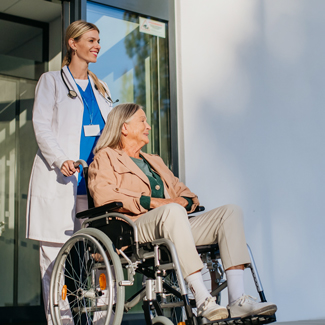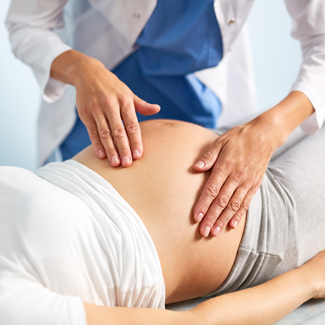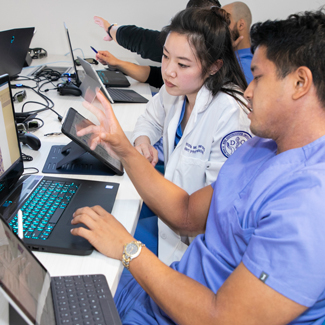Be at the forefront of the most popular way to practice medicine. As a student of the Doctor of Osteopathic Medicine (D.O.) program at Nova Southeastern University's College of Osteopathic Medicine, you'll master the unique combination of scientific knowledge and humanism that is D.O. This four-year program doesn't just prepare you for the real world, it helps you carve your ideal path to be a leader in competent and compassionate care through intensive coursework, clinical reviews, and customized rotation plans.
Professional Preparation That Makes a Difference
Much like traditional medical doctors, D.O.s remain on the cutting edge of research and technology, yet they are equally committed to being compassionate healers, especially to underserved populations.
Your learning experience will reinforce this distinct approach to medicine starting on day one. With access to extensive resources, interprofessional service learnings, and a three-month rotation in a rural or urban medically underserved setting, you'll quickly develop a strong patient-focused mindset that will distinguish you as a professional with expert medical skills and a human touch.

As we explore the next chapter of medical education here at NSU's College of Osteopathic Medicine, we are committed to pursuing a pathway that provides our students with the most comprehensive, equitable and inclusive, cutting-edge, and compassionate learning experience possible.
Elaine M. Wallace, D.O., Dean | Patel College of Osteopathic Medicine
What's the Difference Between a D.O. and an M.D.?
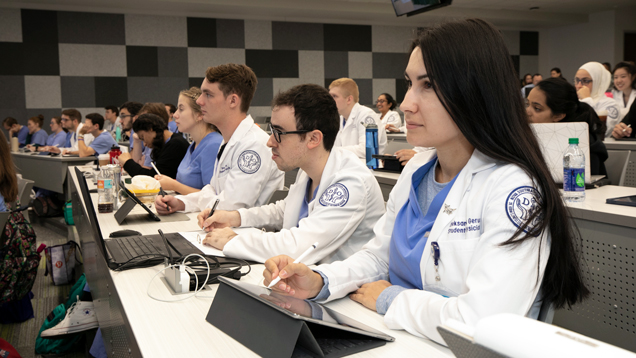
The Doctor of Osteopathic Medicine (D.O.) and Doctor of Medicine (M.D.) are both professional medical degrees that position you to pursue a career as a physician. While training in both degrees focuses on providing the most comprehensive, cutting edge practice of medicine, what sets the D.O. degree and training apart is its core focus on the holistic side of practicing medicine, with a strong historical commitment to supporting medically underserved populations.
Quick Facts
January 15: AACOMAS App Due
March 1: NSU Supplemental App Due
Specialize Your Studies: Explore Academic Departments
Family Medicine
Department of Family MedicineGeriatrics
Department of Geriatric MedicineInternal Medicine
Department of Internal MedicineNutrition
Department of NutritionObstetrics and Gynecology
Department of Obstetrics and GynecologyOsteopathic Principles and Practice
Osteopathic Principles and PracticePediatrics
Department of PediatricsPsychiatry
Department of PsychiatryRural and Urban Underserved
Rural and Urban Underserved MedicineSurgery
Department of SurgeryChoose Your Path to D.O.
NSU’s flexible approach to pursuing a career in osteopathic medicine starts with several options so you can feel good about your starting point, whether that’s getting more clinical experience and prep first or setting out for your doctoral degree right away.
Doctor of Osteopathic Medicine (D.O.)
The D.O. track is a professional degree that requires four years of study.
Doctoral program
- Preclinical training in foundational sciences, clinical skills, and clinical reasoning
- Clinical rotations in all major specialties, including rural and urban under-served medicine, with the elective opportunities in sub-specialty training.
- Opportunity to match into all medical, surgical, and obstetric specialties
M.S. in Foundational and Integrated Medical Sciences (M.S. F.I.M.S.)
A full-time graduate program of study with 18 total credits over 2 semesters.
Graduate-level
- Direct entry into the D.O. program upon completion with a 3.6 GPA
- Enhanced prep for the basic biomedical sciences you will encounter during your first two years at any medical school
D.O. and Master's Degree
Two degrees in four years at a reduced cost
Concurrent Degree
Earn your D.O while earning any of the below degrees:
- Master of Public Health (M.P.H.)
- M.S. in Health Informatics
- M.S. in Disaster and Emergency Management
- M.S. in Medical Education
- M.S. in Nutrition
D.O. and Bachelor's Degree
Are you a high school student looking to plan ahead? Save a spot in NSU's D.O. program while you earn your bachelor's degree.
Dual Admission Program
This option takes seven to eight years to complete this distinctive program.
Accreditation

Nova Southeastern University's College of Osteopathic Medicine has been granted accreditation by the Commission on Osteopathic College Accreditation of the American Osteopathic Association (AOA). This body is recognized by the U.S. Department of Education as the accrediting agency for colleges educating osteopathic physicians and surgeons. The NSU D.O. program ranks as the 10th-largest in terms of total enrollment among the 35 accredited colleges of osteopathic medicine in the United States.
Get the Edge You Need to Become a Healthcare Leader
You won't just become a doctor, you'll become a patient-focused leader. That's the NSU Edge. And you'll experience it every step of the way, from labs with advanced patient simulation technology to interprofessional service-learning opportunities to accelerated tracks to graduation. You'll also have access to extensive professional resources and a tight-knit peer group; so no matter where life takes you after graduation, you'll always have the NSU edge.
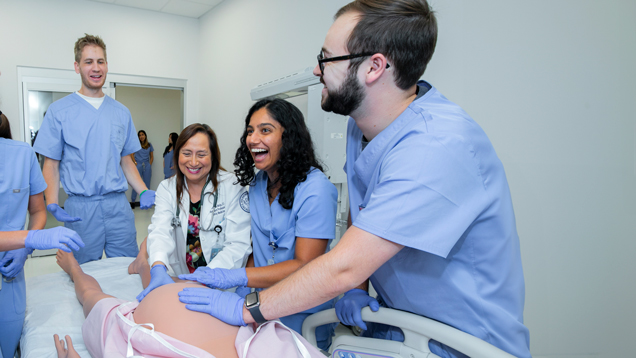
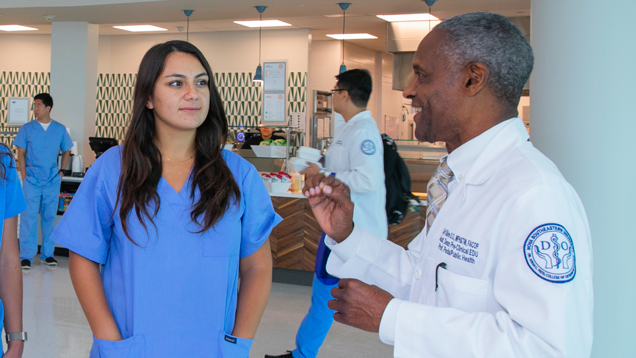
Discover Opportunities for Student Leadership
Find your fit outside the classroom through any of the 50+ student clubs and organizations, leadership opportunities, and exposure to established health professionals, as well as volunteer opportunities. You'll grow beyond the classroom and graduate a well-rounded leader of medicine.
Making the Match: Residency Outcomes
Graduates of the D.O. program continue to excel during the competitive NRMP and other Match Processes. In the past four years, graduating classes have obtained placement into graduate medical education programs at 98% and higher, with the Class of 2022 reaching the college's goal of 100%.

Innovative, Mission-Driven Curriculum
The unique curriculum of the D.O. program provides academic and clinical training, which prepares you for the "real world" of medicine. It will make you more competitive for postdoctoral training positions and more attractive to those interviewing candidates for those positions.
View Program Curriculum
Professional Licensure Disclosure
Nova Southeastern University, Dr. Kiran C. Patel College of Osteopathic Medicine, Doctor of Osteopathic Medicine Program is an AOA-accredited program of study. Graduation from an AOA-COCA accredited college of osteopathic medicine is required in order to begin training in an ACGME-accredited residency program to which he or she has been accepted, and to take the COMLEX-USA Level 3 examination. At this time, we have determined that the KPCOM program meets the educational degree completion requirements for licensure in all 50 states, the District of Columbia and the US protectorates.
Professional Licensure Disclosure Statement (PDF)Checking Your Application Status
You can check your application anytime on the NSU Self-Service Banner (WebSTAR).
After Applying, What Happens Next?
If selected, you’ll receive an invitation from the Office of Admissions to schedule an interview. This personal interview is the next step and does not guarantee admission. Acceptance is on a “rolling” or periodic schedule, and you will receive decision notices via email and mail.




